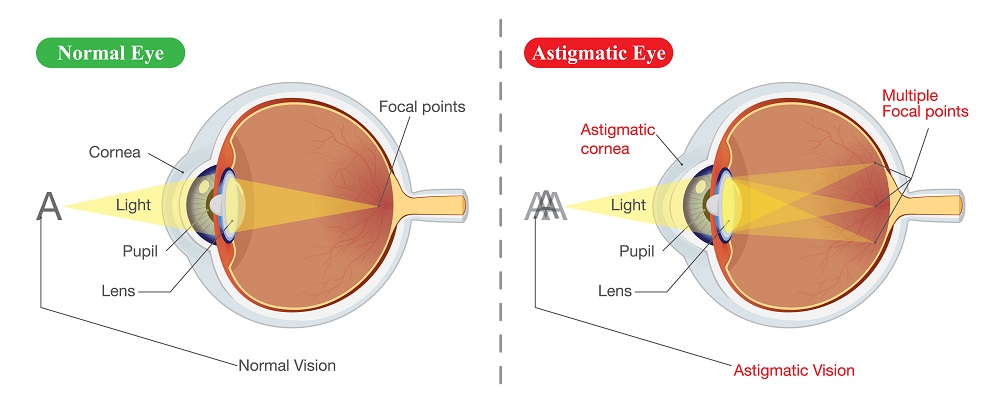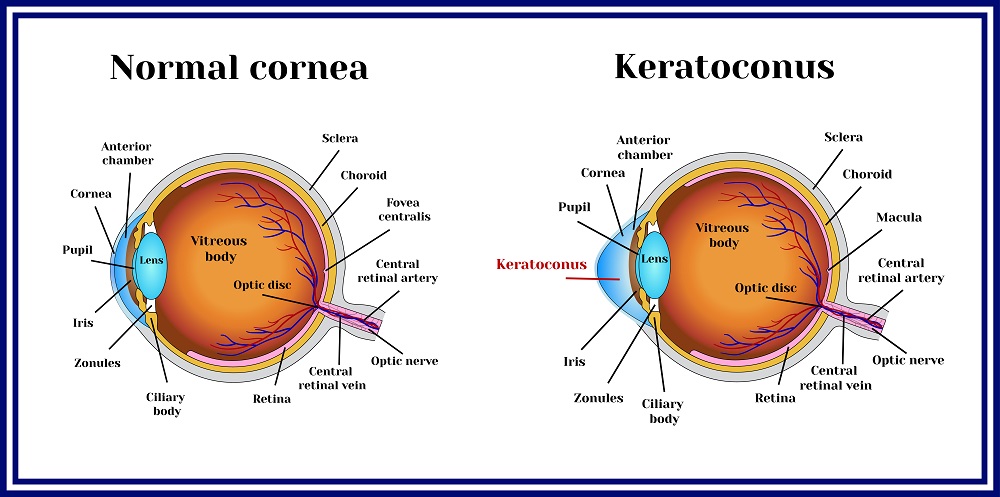Astigmatism is a fairly common eye condition that is relatively easy to remedy. Other conditions like keratoconus are associated with astigmatism but there are subtle differences that account for the difference in treatment.
Astigmatism is the natural process of the cornea changing shape and structure. This causes refractive errors such as blurred and hazy vision or difficulty in viewing at certain ranges. Keratoconus exhibits relatively similar symptoms but occurs primarily due to degenerative thinning of the cornea. Thus, keratoconus demands more sophisticated treatment than astigmatism.
Refractive Error Due to Imperfect Corneal Curvature

The cornea is the front surface layer of the eyes. This is usually spherical for facilitating the proper entry of light for clear vision.
The cornea, however, can become distorted. It can assume an irregular shape along with other components of the eye like the lens and retina which results in blurry vision. This happens because of the error in focusing light entering the eyes properly causing the image formed in the retina to lack fine detail.
A cornea with no astigmatism resembles the shape of a basketball. Regular astigmatism, which refers to the type of astigmatism with 2 curvatures, resembles the shape of a football. Lastly, a cornea with irregular astigmatism, or the type of astigmatism with more than 2 curvatures, resembles the shape of an egg.
Keratoconus as a Form of Astigmatism
Keratoconus occurs when the cornea assumes a cone-like shape. This occurs due to the distortion and thinning of the cornea. Usually, blurred vision is thinner in one eye than the other.
Keratoconus can have various causes. Genetics is often one of the associated causes of the condition. However, overexposure to sunlight, chronic eye illness, and improper use of contact lens can potentially cause keratoconus. Rubbing the eyes can also facilitate the shape distortion in the cornea, leading to keratoconus.
Keratoconus can manifest from the age of 7 years old to 50 years old. Doctors often have difficulty in identifying the progression of keratoconus. However, when left untreated, it can lead to permanent loss of vision.
Keratoconus is a form of irregular astigmatism. This means that the cornea has 3 or more curvatures, forming a cone-like shape. Some of the symptoms of keratoconus are similar to astigmatism. This includes double vision, blurred vision in one or both eyes, and bright lights producing halos.
Keratoconus is untreatable using treatment methods for astigmatism. Soft contact lenses can help during the early phase of keratoconus but will rarely produce any beneficial effects in more advanced cases.
LASIK surgery – one of the most viable solutions for astigmatism – is not advisable for keratoconus because it will only aggravate the thinning of the cornea. In more advanced cases of keratoconus, a corneal transplant is maybe the most viable solution available.
High Astigmatism is Not Always Keratoconus
Astigmatism is usually not recognizable until a person takes an eye test. Some of the most popular eye tests for diagnosing astigmatism are visual acuity tests, astigmatic dial, ophthalmometer or keratometer, and corneal topography.
Astigmatism occurs when the cornea is not able to maintain its spherical structure, causing it to bulge and assume an imperfect shape. This causes the light entering the eyes to be refracted differently. The refractive error causes vision problems like double vision or blurred vision.
Higher cases of astigmatism may lead to keratoconus. Such cases of high astigmatism are often mistaken as keratoconus. However, it only becomes keratoconus when it assumes an outward bulge and forms a cone-like structure.
The type of refractive error differs per case of astigmatism. Myopic astigmatism has a curvature that produces nearsightedness while hyperopic astigmatism has a curvature that produces farsightedness.
Regular and irregular astigmatism are also further distinctions of astigmatism. Regular astigmatism usually occurs as a person ages while irregular astigmatism manifests due to surgery, disease, or trauma. The lens can also suffer from distortion which can also cause a specific type of astigmatism called lenticular astigmatism.
Correcting Astigmatism and Keratoconus

Astigmatism can be corrected through glasses and contact lenses. There are also surgical procedures such as LASIK surgery which removes refractive errors due to imperfections in the cornea.
Rigid contact lenses provide clear vision by adding a new surface to the front of the eyes. This is often for people who suffer from high astigmatism and keratoconus because of its ability to align automatically with the cornea for greater stability. Soft contact lenses are for people with lesser forms of astigmatism. This type of contact lens is prone to displacement and drying.
Scleral contact lenses are also a viable type of contact lens for correcting refractive errors from astigmatism and keratoconus. It is as soft as soft contact lenses but provides as effective support as rigid contact lenses. They are also less prone to drying but require a greater technique to apply.
Keratoconus, however, is an eye illness, unlike astigmatism which is only considered as a natural eye condition. Worse cases of keratoconus cannot be treated with normal prescription glasses and contact lenses. They require more sophisticated tools to correct the refractive errors.
Rigid gas-permeable keratoconus lenses are specialized lenses that transmit oxygen to shape the corneal structure. Scleral keratoconus lenses are another form of contact lens that lies on top of the sclera for correcting refractive errors.
Other effective treatments for keratoconus are Intacs and corneal collagen crosslinking. Intacs involve placing plastic rings to flatten the imperfect curvature of the cornea to restore proper vision. Corneal collagen crosslinking or CXL involves using drops of riboflavin into the eye and using ultraviolet light to activate the natural photosensitizers and improve the structure of the corneal stroma.
Final Thoughts
It is easy to mistake a high form of astigmatism as keratoconus, which involves thinning of the cornea. Knowing the distinction between astigmatism and keratoconus can prevent potentially dangerous treatment methods such as LASIK surgery, which can potentially lead to permanent blindness for people suffering from keratoconus.
References:

